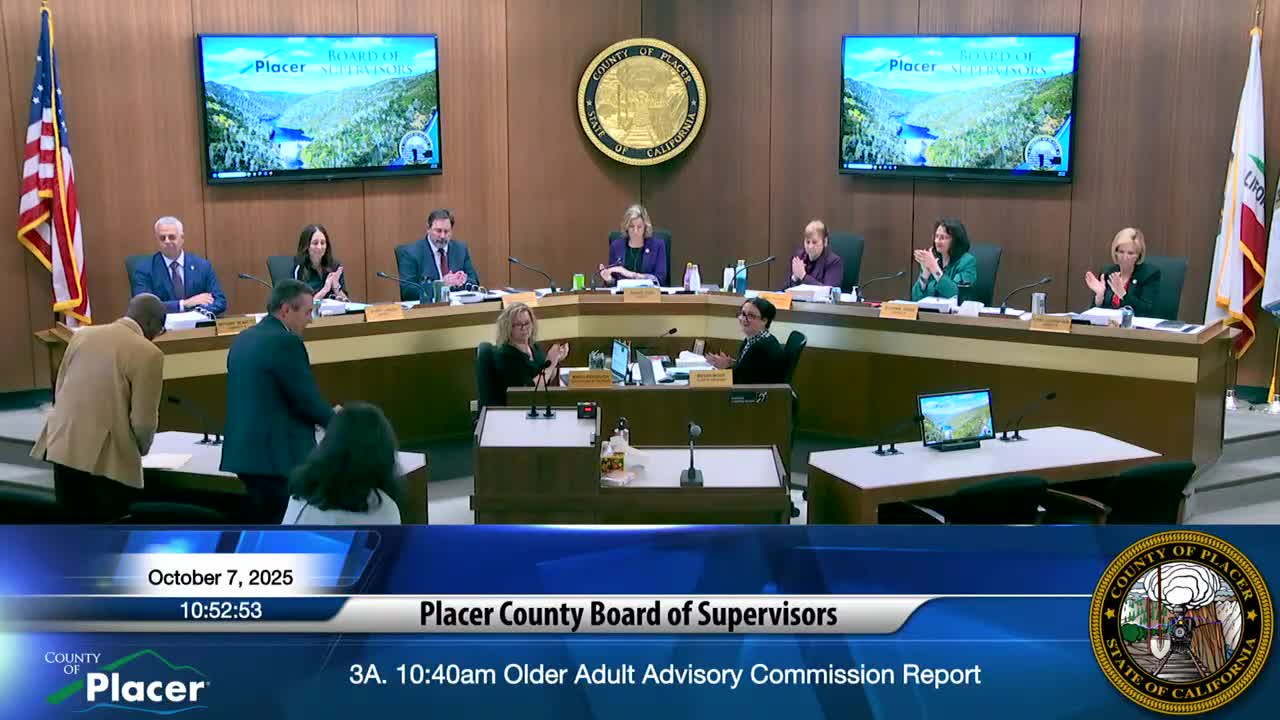Board approves Mill Creek subdivision EIR, rezones 65‑acre Dry Creek site for 322 homes
October 08, 2025 | Placer County, California
This article was created by AI summarizing key points discussed. AI makes mistakes, so for full details and context, please refer to the video of the full meeting. Please report any errors so we can fix them. Report an error »

The Placer County Board of Supervisors voted to certify the final recirculated environmental impact report for the Mill Creek subdivision and approved related land‑use changes, rezoning and tentative map approvals that clear the way for 322 single‑family homes, 33 accessory dwelling units and five parks on a 65.2‑acre site in the Dry Creek area.
The Mill Creek project will change the site’s Dry Creek West Placer community plan designation from low‑density residential and industrial to medium‑ and high‑density residential; rezone roughly 46 acres to an RSP‑4 (4,000 sq ft minimum) zone and 18.8 acres to an RSP‑3 (3,000 sq ft minimum) zone; and authorize two phased subdivision maps, frontage and intersection improvements, and two variance requests including a limited increase in wall/fence heights at some edges and reduced side setbacks on narrow lots.
County planners told the board the recirculated draft EIR found two significant, unavoidable impacts — the primary one tied to conversion of about 13.42 acres of land mapped as unique or prime farmland — and detailed mitigation requirements. The project will mitigate farmland loss by purchasing mitigation lands or paying land conversion fees, and will implement PCCP‑consistent mitigations for habitat and special‑status species where relevant.
Traffic studies reviewed both state VMT and local circulation. The project met the county’s VMT threshold (a per‑capita reduction target) and the county’s local transportation analysis identified specific off‑site improvements, including a Cook Riolo/PFE intersection roundabout and turn‑lane work at Cook Riolo/Vineyard Road. The applicant agreed to construct designated off‑site improvements and fund required drainage and water‑meter relocation work.
Public comment at the board hearing focused on runoff/air quality near the nearby Union Pacific rail yard, water supply and concern about density's compatibility with the community plan. County staff and the EIR consultant described prior air‑quality studies and reductions in diesel particulate from rail‑yard mitigation agreements and said the project uses Cal Am/PCWA surface‑water supplies; water‑supply needs were evaluated in the utilities chapter and by the water supplier’s planning work. Project proponents highlighted park acreage, trail connections and proximity to services as benefits.
The board approved the EIR and the package of land‑use actions with motions recorded on the public record. Conditions of approval require an affordable‑housing agreement (33 ADUs to meet the applicant’s affordable unit equivalency), landscape requirements emphasizing drought‑tolerant/native species, and execution of off‑site traffic and utility improvements prior to final map recordation.
The Mill Creek approvals establish a design and mitigation framework that the developer must follow during engineering, final map and construction permit stages. The project’s construction and phasing schedule will determine when the traffic and school impacts described in the EIR are realized and when county departments must implement required mitigation and monitoring.
The Mill Creek project will change the site’s Dry Creek West Placer community plan designation from low‑density residential and industrial to medium‑ and high‑density residential; rezone roughly 46 acres to an RSP‑4 (4,000 sq ft minimum) zone and 18.8 acres to an RSP‑3 (3,000 sq ft minimum) zone; and authorize two phased subdivision maps, frontage and intersection improvements, and two variance requests including a limited increase in wall/fence heights at some edges and reduced side setbacks on narrow lots.
County planners told the board the recirculated draft EIR found two significant, unavoidable impacts — the primary one tied to conversion of about 13.42 acres of land mapped as unique or prime farmland — and detailed mitigation requirements. The project will mitigate farmland loss by purchasing mitigation lands or paying land conversion fees, and will implement PCCP‑consistent mitigations for habitat and special‑status species where relevant.
Traffic studies reviewed both state VMT and local circulation. The project met the county’s VMT threshold (a per‑capita reduction target) and the county’s local transportation analysis identified specific off‑site improvements, including a Cook Riolo/PFE intersection roundabout and turn‑lane work at Cook Riolo/Vineyard Road. The applicant agreed to construct designated off‑site improvements and fund required drainage and water‑meter relocation work.
Public comment at the board hearing focused on runoff/air quality near the nearby Union Pacific rail yard, water supply and concern about density's compatibility with the community plan. County staff and the EIR consultant described prior air‑quality studies and reductions in diesel particulate from rail‑yard mitigation agreements and said the project uses Cal Am/PCWA surface‑water supplies; water‑supply needs were evaluated in the utilities chapter and by the water supplier’s planning work. Project proponents highlighted park acreage, trail connections and proximity to services as benefits.
The board approved the EIR and the package of land‑use actions with motions recorded on the public record. Conditions of approval require an affordable‑housing agreement (33 ADUs to meet the applicant’s affordable unit equivalency), landscape requirements emphasizing drought‑tolerant/native species, and execution of off‑site traffic and utility improvements prior to final map recordation.
The Mill Creek approvals establish a design and mitigation framework that the developer must follow during engineering, final map and construction permit stages. The project’s construction and phasing schedule will determine when the traffic and school impacts described in the EIR are realized and when county departments must implement required mitigation and monitoring.
View full meeting
This article is based on a recent meeting—watch the full video and explore the complete transcript for deeper insights into the discussion.
View full meeting
